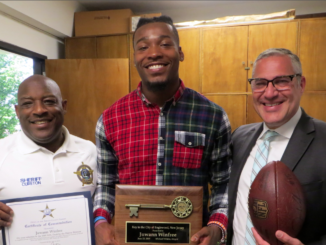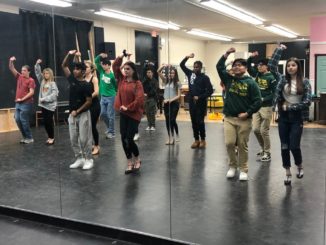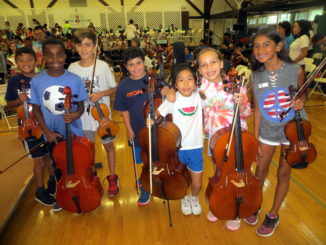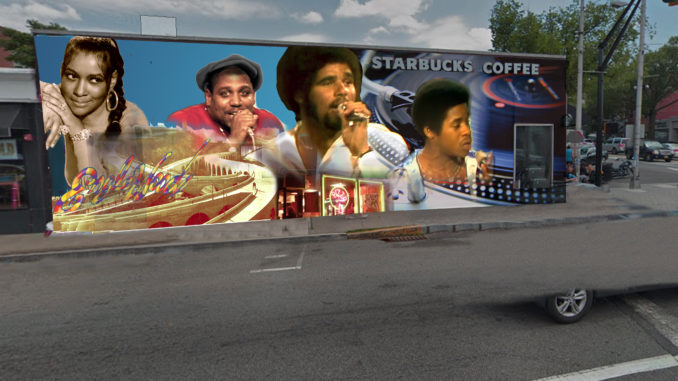
ENGLEWOOD, N.J.—Earlier this year, Omar Lopez, a resident active in community and school affairs, had an idea for a public mural celebrating Englewood’s place in hip-hop: a depiction of the city’s original hip-hop trio that popularized rap music with “Rapper’s Delight”—the first-ever top 40 rap single, released in September 1979.
So he started working with a designer, artist and got permission from local owners and corporate headquarters of Starbucks for a mural honoring the Sugarhill Gang on the popular East Palisade Avenue coffee shop’s wall, an idea he presented for approval in May to the Planning Board.
Since then, he has amassed a multitude of emails—and delays—from city agencies in his continuing efforts to get the go-ahead for a public mural on Starbucks to honor the Sugarhill Gang. The proposed mural also honors Sylvia Robinson, music producer for “Rapper’s Delight.”
‘Rapper’s Delight’ homage
In fact, on Tuesday, Sept. 17, when he rushed down to a City Council meeting taking place that night to ask whatever happened to his application for a mural honoring Sugarhill Gang, he said that day was actually the 40th anniversary of the release of “Rapper’s Delight,” an occasion which passed, noted Lopez, without a mural to honor the city’s role in music history.
At the meeting, City Council members introduced an ordinance, “Murals and Public Art Installations,” which must go to the Planning Board for review and then a public hearing Oct. 29 before it comes to council for adoption, said city clerk Yancy Wazirmas.
Lopez said he had been told he should wait for such an ordinance to be in place before he moved forward with plans for a public mural on Starbucks.
But the long-delayed ordinance to establish a process to permit public murals in Englewood—which Lopez was patiently waiting for—drew sharp exchanges Sept. 17 between the mayor, a councilman and Lopez.
All were upset about how “the process” of applying for a public mural approval in Englewood was unclear and appeared to favor one applicant over another.
Lopez was upset after waiting for five months to get council approval for a public mural—only to be told by officials Sept. 17 that he could have sought approval at any time from the Code Enforcement Office.
Lopez was also upset because he had heard council members say only one application for a public mural had been submitted—a proposal from a newly opened NJ Eye and Ear on Palisade Avenue.
Another application from the city’s Special Improvement District was submitted for a public mural, said interim Borough Administrator Jewel Thompson-Chin. Details were not made public.
“I’ve been very patient and diligent in following up with the city to get this approved,” Lopez told Northern Valley Press Sept. 19. He said, as Council President Katharine Glynn advised, he followed up Sept. 18 with the city attorney to find out what happened to his mural application and its status and was told it was being looked into.
Lopez said while he had no problems waiting until a mural ordinance was passed, he was most upset and caught off-guard by the city’s expedited consideration of a proposal for a public mural from a commercial entity.
Most frustrating to Lopez, he said, was that his previously submitted proposal for a public mural celebrating Englewood’s hip hop milestone was not even mentioned and apparently, when officials started looking for it, it could not even be found.
He said he was also upset with the council’s apparent indifference to his longstanding efforts to bring pride, inspiration and beauty to the city’s streets with public art projects and murals.
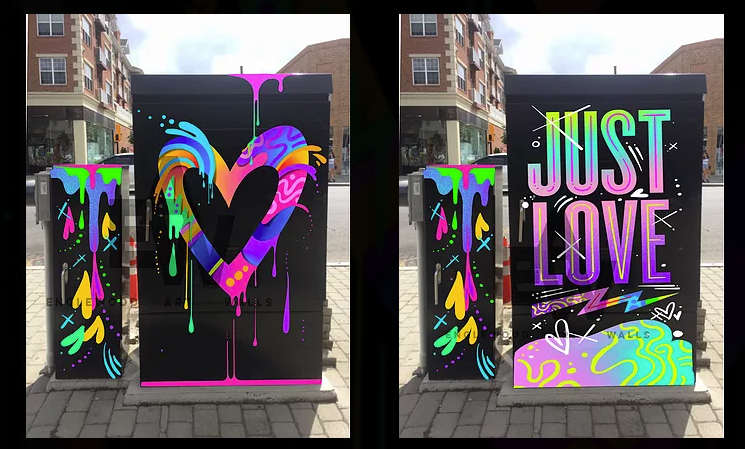
‘Right kind of support’
“I really wanted this mural program to have the right kind of support from Englewood and to put something into place where we would only allow high-quality murals and art to be put up in the city,” said Lopez. “I think there’s a real systemic effort to suppress my (mural) application as I’ve tried to work with everyone,” he said.
Lopez said he presented his proposal to the Planning Board’s signage committee and still awaits a response.
“This is about how I have an initiative to celebrate local heroes that has been shelved and they’ve been giving me the run-around for months. It feels fishy to me,” he added.
He said he has tried for years to bring public art to Englewood, backed by local business and not-for-profit support.
Most efforts are included at a website, englewoodartwalls.com, which shows proposed public art such as the Sugarhill Gang mural, examples of artwork on utility boxes downtown and a proposed Tryon Pool art installation at the field house, sprinkler area and shower wall.
He said he submitted a proposal in 2018 for painting utility boxes in downtown Englewood, which was discussed but not approved and was told to instead focus immediate efforts on private property, which resulted in a mural tribute to Sugarhill Gang.
‘What is correct process?’
“I’ve asked repeatedly ‘what is the correct process?’ and tried to build relationships with all the different communities throughout Englewood,” said Lopez.
Mayor Michael Wildes said public murals ordinance 19-14, introduced Sept. 17, was delayed due to city attorneys’ review to make sure it passed constitutional muster.
He said after Lopez texted him mid-meeting Sept. 17 to ask about his proposed Sugarhill Gang mural—while Lopez watched the City Council meeting on a live Facebook stream—he texted Lopez back and told him to come to the meeting if available, which Lopez did.
Subverting ‘the process’
When acting city attorney Levi Kool told members that absent a current ordinance on murals, applicants could apply directly to the Code Enforcement Office for approval, councilman Charles Cobb strongly objected to allowing such a move.
He said that allowing applicants to apply to the Code Enforcement Office was bypassing “the process” and ordinance the council was trying to establish.
After back-and-forth between Cobb and Wildes over how public murals should be approved, and whether approving murals without an ordinance in place made sense, Cobb voted against introducing the murals ordinance saying he supported the ordinance but did not support a “process like this” to allow applicants to apply directly to code enforcement for approval.
Efforts to reach Kool for an update on Lopez’s proposal were not returned by press time.
No copies of the ordinance were available online or in print for residents to view before the council introduction and vote.
Other municipalities make draft ordinances available online with council agendas prior to introduction although open public records laws do not require such transparency.
Photos courtesy Omar Lopez, englewoodartwalls.com

